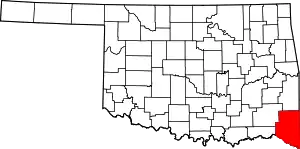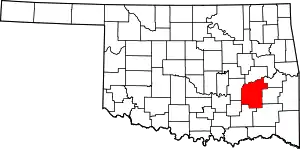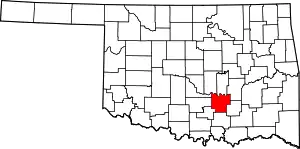Choctaw Nation of Oklahoma
The Choctaw Nation (Choctaw: Chahta Okla) is a Native American[2] indigenous tribe covering about 6,952,960 acres (28,138 km2; 10,864 sq mi), occupying portions of southeastern Oklahoma in the United States.[3] It is the third-largest federally recognized tribe in the United States and the second-largest Indian reservation in area after the Navajo. As of 2011, the tribe has 223,279 enrolled members, of whom 84,670 live within the state of Oklahoma[4] and 41,616 live within the Choctaw Nation's jurisdiction.[5] A total of 233,126 people live within these boundaries, with its tribal jurisdictional area compromising 10.5 counties in the state.
Choctaw Nation
Chahta Okla | |
|---|---|
 Flag  Seal | |
| Anthem: ("Nahata Fichik Tohwikeli" and "Antvt bilia" used for some occasions) | |
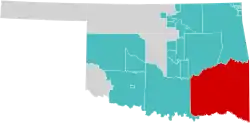 Location (red) in the U.S. state of Oklahoma | |
| Established | September 27, 1830 (Treaty) |
| Expansions | 1843–1855 |
| Reductions | 1860–1867 |
| Constitution | January 11, 1860 |
| Annexation by U.S. | November 16, 1907 |
| Self-determination | 1971 |
| Capital | Durant (de facto) Tuskahoma (de jure) |
| Subdivisions | 12 Districts |
| Government | |
| • Body | Choctaw Nation Council |
| • Chief | Gary Batton |
| • Assistant Chief | Jack Austin, Jr. |
| • Speaker of the Choctaw Council | Thomas Williston |
| • Chief Justice | David Burrage |
| • U.S. House Delegate-designee | Vacant |
| Area | |
| • Total | 28,140 km2 (10,864 sq mi) |
| Demonym(s) | Choctaw |
| Time zone | CST |
| Website | choctawnation |
 | |
| Total population | |
|---|---|
| 223,279 total enrollment, 84,670 enrolled in Oklahoma[1] | |
| Regions with significant populations | |
| United States (Oklahoma) | |
| Languages | |
| English, Choctaw | |
| Religion | |
| Evangelical Protestantism | |
| Related ethnic groups | |
| other Choctaw bands, Chickasaw |
By area, the Choctaw Nation is larger than eight U.S. states – Hawaii, Massachusetts, Vermont, New Hampshire, New Jersey, Connecticut, Delaware and Rhode Island – and is larger than the combined area of the last three (Connecticut through Rhode Island).
The chief of the Choctaw Nation is Gary Batton, who took office on April 29, 2014, after the retirement of Gregory E. Pyle.[6] The Choctaw Nation Headquarters, which houses the office of the Chief, is located in Durant.[1] Durant is also the seat of the tribe's judicial department, housed in the Choctaw Nation Judicial Center, near the Headquarters. The tribal legislature meets at the Council House, across the street from the historic Choctaw Capitol Building, in Tuskahoma. The Capitol Building has been adapted for use as the Choctaw Nation Museum. The largest city in the nation is McAlester.
The Choctaw Nation is one of three federally recognized Choctaw tribes; the others are the sizable Mississippi Band of Choctaw Indians, with 10,000 members and territory in several communities, and the Jena Band of Choctaw Indians in Louisiana, with a few hundred members. The latter two bands are descendants of Choctaw who resisted the forced relocation to Indian Territory. The Mississippi Choctaw preserved much of their culture in small communities and reorganized as a tribal government in 1945 under new laws after the Indian Reorganization Act of 1934.
Those Choctaw who removed to the Indian Territory, a process that went on into the early 20th century, are federally recognized as the Choctaw Nation of Oklahoma.[7] The removals became known as the "Trail of Tears."
The original territory has expanded and shrunk several times since the 19th century.
Terminology
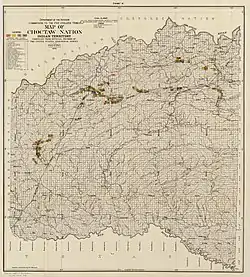
In English, the official name for the area was "Choctaw Nation", as outlined in Article III of the 1866 Reconstruction Treaty following the Civil War. During its time of sovereignty within the United States Indian Territory, it also utilized the title "Choctaw Republic".[8] Since 1971, it is officially referred to as the Choctaw Nation of Oklahoma. The Choctaw Nation maintains a special relationship with both the federal and Oklahoma governments.
Officially a domestic dependent nation since 1971, in July 2020, the Supreme Court ruled in McGirt v. Oklahoma that the eastern area of Oklahoma- about half of the modern state- never lost its status as a Native reservation. This includes the city of Tulsa (located between Muscogee and Cherokee territory). The area includes lands of the Chickasaw, Choctaw, Cherokee, Muscogee and Seminole. Among other effects, the decision potentially overturns convictions of over a thousand cases in the area involving tribe members convicted under state laws.[9] The ruling is based on an 1832 treaty, which the court ruled was still in force, adding that "Because Congress has not said otherwise, we hold the government to its word."[10] As such, the Choctaw Nation returned from a domestic dependent nation status to that of an Indian reservation.[11]
Geography


The Choctaw Nation of Oklahoma's tribal jurisdictional area covers 10,864 square miles (28,140 km2), encompassing eight whole counties and parts of five counties in Southeastern Oklahoma:
- Atoka County,
- most of Bryan County,
- Choctaw County,
- most of Coal County,
- Haskell County,
- half of Hughes County,
- a portion of Johnston County,
- Latimer County,
- Le Flore County,
- McCurtain County,
- Pittsburg County,
- a portion of Pontotoc County, and
- Pushmataha County.
Government
.jpg.webp)

The Tribal Headquarters are located in Durant. Opened in June 2018, the new headquarters is a 5-story, 500,000 square foot building located on an 80-acre campus in south Durant. It is near other tribal buildings, such as the Regional Health Clinic, Wellness Center, Community Center, Child Development Center, and Food Distribution.[12] Previously, headquarters was located in the former Oklahoma Presbyterian College, with more offices scattered around Durant. The current chief is Gary Batton[6] and the assistant chief is Jack Austin, Jr. The Tribal Council meet monthly at Tvshka Homma.
The tribe is governed by the Choctaw Nation Constitution, which was ratified by the people on June 9, 1984. The constitution provides for an executive, a legislative and a judicial branch of government. The chief of the Choctaw Tribe, elected every four years, is not a voting member of the Tribal Council. These members are elected from single-member districts for four-year terms. The legislative authority of the tribe is vested in the Tribal Council, which consists of twelve members.
The General Fund Operating Budget, the Health Systems Operating Budget, and the Capital Projects Budget for the fiscal year beginning October 1, 2017 and ending September 30, 2018 was $516,318,568.[13]
Politically, the Choctaw Nation is predominantly encompassed by Oklahoma's 2nd congressional district, represented by Republican Markwayne Mullin, a Cherokee. However some smaller strands are located within the 4th congressional district, represented by Republican Tom Cole, a Chickasaw. With a majority of both Native American and white voters in the region leaning conservative, Republican Donald Trump carried every county in the Choctaw Nation in the 2020 election, as well as every county in the state of Oklahoma, continuing a trend seen in the 2004, 2008, 2012 and 2016 elections. The Choctaw Nation is located in one of the most conservative areas of Oklahoma, and while registered Democrats outnumber Republicans, the region has consistently gone to Republican candidates.
The current head of the government, Chief Gary Batton, is a Democrat. The Chief that preceded him, Gregory Pyle, was as well.
The Choctaw Nation also has the right to appoint a non-voting delegate to the U.S. House of Representatives, per the 1830 Treaty of Dancing Rabbit Creek; as of 2020 however, no delegate has been named or sent to the Congress by the Choctaw Nation. Chief Gary Batton is said to be observing the process of the Cherokee Nation nominating their treaty-stipulated delegate to the U.S. House before proceeding. In late June 2020, Chief Batton sent a letter to U.S. House Speaker Nancy Pelosi to discuss Choctaw Nation membership as a non-voting delegate to the House, and concerning Maxine Waters' provision to withhold federal coronavirus aid from the Tribe unless the Choctaw Nation "resolved the Freedman issue." Batton said in the letter that would require violating the Choctaw Constitution and the 1866 Treaty with the U.S. Government and was "a non-starter," and asked that Pelosi “not permit the House to adopt any legislative provision that would so fundamentally destroy the self-determination authority of the Choctaw Nation.”[14]
Executive Department
The supreme executive power of the Choctaw Nation is assigned to a chief magistrate, styled as the "Chief of the Choctaw Nation". The Assistant Chief is appointed by the Chief with the advice and consent of the Tribal Council, and can be removed at the discretion of the Chief.[15] The current Chief of the Choctaw Nation is Gary Batton, and the current Assistant Chief is Jack Austin, Jr.
The Chief's birthday (Batton's is December 15) is a tribal holiday.
History
Before Oklahoma was admitted to the union as a state in 1907, the Choctaw Nation was divided into three districts: Apukshunnubbee, Moshulatubbee, and Pushmataha. Each district had its own chief from 1834 to 1857; afterward, the three districts were put under the jurisdiction of one chief. The three districts were re-established in 1860, again each with their own chief, with a fourth chief to be Principal Chief of the tribe.[16] These districts were abolished at the time of statehood, as tribal government and land claims were dissolved in order for the territory to be admitted as a state. The tribe later reorganized to re-establish its government.
List of Chiefs

| Choctaw Nation, Indian Territory (1834-1906) |
Districts | |||||
|---|---|---|---|---|---|---|
| Moshulatubbee | Apukshunnubbee | Pushmataha | ||||
| District Chief | Term | District Chief | Term | District Chief | Term | |
| Moshulatubbee | 1834-1836 | Thomas LeFlore | 1834-1838 | Nitakechi | 1834-1838 | |
| Joseph Kincaid | 1836-1838 | |||||
| John McKinney | 1838-1842 | James Fletcher | 1838-1842 | Pierre Juzan | 1838-1841 | |
| Nathaniel Folsom | 1842-1846 | Thomas LeFlore | 1842-1850 | Isaac Folsom | 1841-1846 | |
| Peter Folsom | 1846-1850 | Salas Fisher | 1846-1850 | |||
| Cornelius McCurtain | 1850-1854 | George W. Harkins | 1850-1857 | George Folsom | 1850-1854 | |
| David McCoy | 1854-1857 | Nicholas Cochnauer | 1854-1857 | |||
| Districts abolished in 1857 | ||||||
| Unified Nation | ||||||
| Governor | Term | Party | ||||
| Alfred Wade | 1857-1858 | None | ||||
| Tandy Walker | 1858-1859 | None | ||||
| Basil LeFlore | 1859-1860 | None | ||||
| Principal Chief | Term | Party | ||||
| George Hudson | 1860-1862 | National | ||||
| Samuel Garland | 1862-1864 | National | ||||
| Peter Pitchlynn | 1864-1866 | National | ||||
| Allen Wright | 1866-1870 | National | ||||
| William Bryant | 1870-1874 | Union | ||||
| Coleman Cole | 1874-1878 | Union | ||||
| Isaac Levi Garvin | 1878-1880 | National | ||||
| Jackson F. McCurtain | 1880-1884 | Republican | ||||
| Edmund McCurtain | 1884-1886 | Republican | ||||
| Thompson McKinney | 1886-1888 | Union | ||||
| Benjamin Smallwood | 1888-1890 | National | ||||
| Wilson N. Jones | 1890-1894 | Union | ||||
| Jefferson Gardner | 1894-1896 | Union | ||||
| Green McCurtain | 1896-1900 | Republican | ||||
| Gilbert Wesley Dukes | 1900-1902 | Union | ||||
| Green McCurtain | 1902-1906 | Republican | ||||
| Choctaw Nation of Oklahoma (1906–Present) | ||||||
| Chief | Term | Party | ||||
| Green McCurtain | 1906-1910 (Appointed by Roosevelt in 1906) |
Republican | ||||
| Victor Locke, Jr. | 1910-1918 (Appointed by Taft) |
Republican | ||||
| William F. Semple | 1918-1922 (Appointed by Wilson) |
Democratic | ||||
| William H. Harrison | 1922-1929 (Appointed by Harding) |
Democratic | ||||
| Ben Dwight | 1929-1937 (Appointed by Hoover) |
Republican | ||||
| William A. Durant | 1937-1948 (Appointed by Roosevelt) |
Democratic | ||||
| Harry J. W. Belvin |
1948-1959 |
Democratic | ||||
| C. David Gardner | 1975-1978 | Democratic | ||||
| Hollis E. Roberts | 1978-1997 | Democratic | ||||
| Gregory E. Pyle | 1997-2014 | Democratic | ||||
| Gary Batton | 2014–Present | Democratic | ||||
Legislative department
The legislative authority is vested in the Tribal Council. Members of the Tribal Council are elected by the Choctaw people, one for each of the twelve districts in the Choctaw Nation.[17]
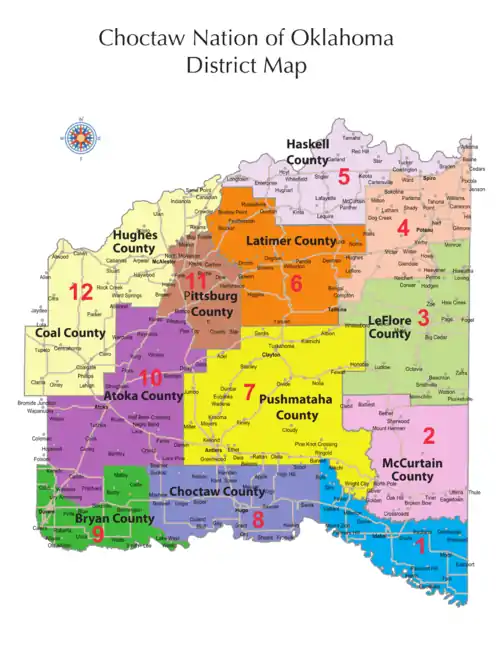
| Current Tribal Council | ||||
|---|---|---|---|---|
| District | Portrait | Councilman | First elected | Term ends |
| District 1 | Thomas Williston | November 29, 2010 | September 4, 2023 | |
| District 2 | Johnathan Ward | September 7, 2015 | September 4, 2023 | |
| District 3 | Eddie Bohanan | September 2, 2019 | September 4, 2023 | |
| District 4 | Delton Cox | September 3, 2001 | September 5, 2021 | |
| District 5 | Ronald Perry | September 5, 2011 | September 4, 2023 | |
| District 6 | Jennifer Woods | September 4, 2017 | September 5, 2021 | |
| District 7 | Jack Austin | September 3, 2001 | September 5, 2021 | |
| District 8 | Perry Thompson | September 1, 1987 | September 4, 2023 | |
| District 9 | James Dry | September 4, 2017 | September 5, 2021 | |
| District 10 | Anthony Dillard | September 5, 2005 | September 5, 2021 | |
| District 11 | Robert Karr | September 2, 2019 | September 4, 2023 | |
| District 12 | James Frazier | September 3, 1990 | September 5, 2021 | |
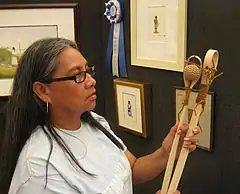
In order to be elected as council members, candidates must have resided in their respective districts for at least one year immediately preceding the election. "Candidates for the Tribal Council must be at least one-fourth (1/4) Choctaw Indian by blood and must be twenty-one (21) years of age or older at the time they file for election."[18] Once elected, a council member must remain a resident of the district from which he or she was elected during the term in office. This policy ensures the involvement and interaction of successful candidates with their constituency.
Once in office, the Tribal Council members have regularly scheduled county council meetings. The presence of these tribal leaders in the Indian community creates a sense of understanding of their community and its needs. The Tribal Council is responsible for adopting rules and regulations which govern the Choctaw Nation, for approving all budgets, making decisions concerning the management of tribal property, and all other legislative matters. The Tribal Council Members are the voice and representation of the Choctaw people in the tribal government.
The Tribal Council assists the community to implement an economic development strategy and to plan, organize, and direct Tribal resources to achieve self-sufficiency. The Tribal Council is working to strengthen the Nation's economy, with efforts being focused on the creation of additional job opportunities through promotion and development. By planning and implementing its own programs and building a strong economic base, the Choctaw Nation applies its own fiscal, natural, and human resources to develop self-sufficiency.
Judicial department
The judicial authority of the Choctaw Nation is assigned to the Court of General Jurisdiction (which includes the District Court and the Appellate Division) and the Constitutional Court. The Constitutional Court consists of a three-member court, who are appointed by the Chief. At least one member, the presiding judge (Chief Justice), must be a lawyer licensed to practice before the Supreme Court of Oklahoma.
Members
- Constitutional Court[19]
–Chief Justice David Burrage
–Judge Mitch Mullen
–Judge Frederick Bobb
- Appellate Division[20]
–Presiding Judge Pat Phelps
–Judge Bob Rabon
–Judge Warren Gotcher
- District Court[21]
–Presiding District Judge Richard Branam
–District Judge Mark Morrison
–District Judge Rebecca Cryer
Economy
The Choctaw Nation's annual tribal economic impact in 2010 was over $822,280,105.[22] The tribe employs nearly 8,500 people worldwide;[23] 2,000 of those work in Bryan County, Oklahoma. The Choctaw Nation is also the largest single employer in Durant. The nation's payroll is about $260 million per year, with total revenues from tribal businesses and governmental entities topping $1 billion.
The nation has contributed to raising Bryan County's per capita income to about $24,000. The Choctaw Nation has helped build water systems and towers, roads and other infrastructure, and has contributed to additional fire stations, EMS units and law enforcement needs that have accompanied economic growth.
The Choctaw Nation operates several types of businesses. It has seven casinos, 14 tribal smoke shops, 13 truck stops, and two Chili's franchises in Atoka and Poteau.[1] It also owns a printing operation, a corporate drug testing service, hospice care, a metal fabrication and manufacturing business, a document backup and archiving business, and a management services company that provides staffing at military bases, embassies and other sites, among other enterprises.
Health system
.jpg.webp)
The Choctaw Nation is the first indigenous tribe in the United States to build its own hospital with its own funding.[24] The Choctaw Nation Health Care Center, located in Talihina, is a 145,000-square-foot (13,500 m2) health facility with 37 hospital beds for inpatient care and 52 exam rooms. The $22 million hospital is complete with $6 million worth of state-of-the-art equipment and furnishing. It serves 150,000–210,000 outpatient visits annually. The hospital also houses the Choctaw Nation Health Services Authority, the hub of the tribal health care services of Southeastern Oklahoma.
The tribe also operates eight Indian clinics, one each in Atoka, Broken Bow, Durant, Hugo, Idabel, McAlester, Poteau, and Stigler.
2008 Freedom Award
In July 2008, the United States Department of Defense announced the 2008 Secretary of Defense Employer Support Freedom Award recipients. They are awarded the highest recognition given by the U.S. Government to employers for their outstanding support of employees who serve in the National Guard and Reserve.
The Choctaw Nation was one of 15 recipients of that year's Freedom Award, selected from 2,199 nominations. Its representatives received the award September 18, 2008 in Washington, D.C. The Choctaw Nation is the first Native American tribe to receive this award.
History
Treaty of Dancing Rabbit Creek (1830)
At Andrew Jackson's request, the United States Congress opened a fierce debate on an Indian Removal Bill.[25] In the end, the bill passed, but the vote was very close: The Senate passed the measure, 28 to 19, while in the House it passed, 102 to 97. Jackson signed the legislation into law June 30, 1830,[25] and turned his focus onto the Choctaw in Mississippi Territory.
On August 25, 1830, the Choctaws were supposed to meet with Jackson in Franklin, Tennessee, but Greenwood Leflore, a district Choctaw chief, informed Secretary of War John H. Eaton that the warriors were fiercely opposed to attending.[26] Jackson was angered. Journalist Len Green writes "although angered by the Choctaw refusal to meet him in Tennessee, Jackson felt from LeFlore's words that he might have a foot in the door and dispatched Secretary of War Eaton and John Coffee to meet with the Choctaws in their nation."[27] Jackson appointed Eaton and General John Coffee as commissioners to represent him to meet the Choctaws at the Dancing Rabbit Creek near present-day Noxubee County, Mississippi.
Say to them as friends and brothers to listen [to] the voice of their father, & friend. Where [they] now are, they and my white children are too near each other to live in harmony & peace.... It is their white brothers and my wishes for them to remove beyond the Mississippi, it [contains] the [best] advice to both the Choctaws and Chickasaws, whose happiness... will certainly be promoted by removing.... There... their children can live upon [it as] long as grass grows or water runs.... It shall be theirs forever... and all who wish to remain as citizens [shall have] reservations laid out to cover [their improv]ements; and the justice due [from a] father to his red children will [be awarded to] them. [Again I] beg you, tell them to listen. [The plan proposed] is the only one by which [they can be] perpetuated as a nation.... I am very respectfully your friend, & the friend of my Choctaw and Chickasaw brethren. Andrew Jackson. -Andrew Jackson to the Choctaw & Chickasaw Nations, 1829.[28]
The commissioners met with the chiefs and headmen on September 15, 1830, at Dancing Rabbit Creek.[29] In carnival-like atmosphere, the policy of removal was explained to an audience of 6,000 men, women, and children.[29] The Choctaws would now face migration or submit to US law as citizens.[29] The treaty would sign away the remaining traditional homeland to the US; however, a provision in the treaty made removal more acceptable:


ART. XIV. Each Choctaw head of a family being desirous to remain and become a citizen of the States, shall be permitted to do so, by signifying his intention to the Agent within six months from the ratification of this Treaty, and he or she shall thereupon be entitled to a reservation of one section of six hundred and forty acres of land.... -Treaty of Dancing Rabbit Creek, 1830
On September 27, 1830, the Treaty of Dancing Rabbit Creek was signed. It represented one of the largest transfers of land that was signed between the US government and Native Americans without being instigated by warfare. By the treaty, the Choctaws signed away their remaining traditional homelands, opening them up for European-American settlement. The Choctaw were the first to walk the Trail of Tears. Article XIV allowed for nearly 1300 Choctaws to remain in the state of Mississippi and to become the first major non-European ethnic group to become US citizens.[30][31][32][33] Article 22 sought to put a Choctaw representative in the U.S. House of Representatives.[30] The Choctaw at this crucial time split into two distinct groups: the Choctaw Nation of Oklahoma and the Mississippi Band of Choctaw Indians. The nation retained its autonomy, but the tribe in Mississippi submitted to state and federal laws.[34]
To the voters of Mississippi. Fellow Citizens:-I have fought for you, I have been by your own act, made a citizen of your state; ... According to your laws I am an American citizen, ... I have always battled on the side of this republic ... I have been told by my white brethren, that the pen of history is impartial, and that in after years, our forlorn kindred will have justice and "mercy too" ... I wish you would elect me a member to the next Congress of the [United] States.-Mushulatubba, Christian Mirror and N.H. Observer, July 1830.[35]
1830 - 1860: Establishment in Oklahoma
The Indian Removal Act, a specific implementation of the Removal Policy, was signed by President Andrew Jackson on May 28, 1830. The Act transformed most of the current state of Oklahoma into an Indian Territory, where southern aboriginal natives (Cherokee, Chickasaw, Choctaw, Creek and Seminole, also called the Five Civilized Tribes) were relocated. The Trail of Tears is a name given to the forced relocation of the Choctaw Nation in 1831. In 1834, Congress created the first Indian Territory,[36] with the Five Civilized Tribes occupying the land that became the State of Oklahoma, excluding its panhandle.
Influence of Cyrus Kingsbury's Choctaw Mission
The Reverend Cyrus Kingsbury, who had ministered among the Choctaw since 1818, accompanied the Choctaws from the Mayhew Mission in Oktibbeha County, Mississippi to their new location in Indian Territory.[lower-alpha 1] He established the church in Boggy Depot in 1840. The church building was the temporary capitol of the Choctaw Nation in 1859. Allen Wright (principal chief of the Choctaw Republic from late 1866 to 1870) lived much of his early life with Kingsbury at Doaksville and the mission school at Pine Ridge. Armstrong Academy was founded in Chahta Tamaha, Indian Territory as a school for Choctaw boys in 1844.[38] It was named after William Armstrong, a popular agent of the Choctaws.
Great Irish Famine aid (1847)

Midway through the Great Irish Famine (1845–1849), a group of Choctaw collected $170 ($5,000 in current dollar terms) and sent it to help starving Irish men, women and children. "It had been just 16 years since the Choctaw people had experienced the Trail of Tears, and they had faced starvation… It was an amazing gesture. By today's standards, it might be a million dollars," wrote Judy Allen in 1992, editor of the Choctaw Nation of Oklahoma's newspaper, Bishinik. To mark the 150th anniversary, eight Irish people came to the US to retrace the Trail of Tears to raise money for Somalian relief.[39] (Following publication of Angie Debo's The Rise and Fall of the Choctaw Republic, various articles corrected the cited amount of this donation, saying it was $170 ($5,000).)
In 2015 a sculpture known as Kindred Spirits was erected in the town of Midleton, County Cork, Ireland to commemorate the Choctaw Nation's donation. A delegation of 20 members of the Choctaw Nation attended the opening ceremony along with the County Mayor of Cork.
In 2018 Irish Taoiseach (Prime Minister) Leo Varadkar announced the Choctaw-Ireland Scholarship Programme - an opportunity for Choctaw students to study in Ireland. The program was launched "in recognition of the act of generosity and humanitarianism shown by the Choctaw Nation of Oklahoma towards the people of Ireland during the Great Famine of the mid-Nineteenth Century, and to foster and deepen the ties between the two nations today".
1855: Controversy over Slaveholding and separation from Chickasaw Nation
In Spring 1855, the ABCFM sent Dr. George Warren Wood to visit the Choctaw Mission in Oklahoma to resolve a crisis over the abolition issue.[40] After arriving in Stockbridge Mission, Wood spent over two weeks days visiting missions including the Goodwater Mission, Wheelock Academy, Spencer Academy, and other mission schools. He met with missionaries to discuss Selah B Treat's June 22, 1848 letter permitting them to maintain fellowship with slaveholders.[41] Ultimately, the crisis was not resolved, and by 1859, the Board cut ties to the Choctaw mission altogether.
In 1855, the Choctaw and Chickasaw Nations formally separated. Doaksville served as the capital of the Choctaw Nation between 1860 and 1863. An 1860 convention in Doaksville ratified the Doaksville Constitution that guided the Choctaw Nation until 1906. The capital moved to Mayhew Mission in 1859, then to Chahta Tamaha in 1863.[42] The Oklahoma Historical Society claims that Doaksville began to decline in importance in 1854, when the U.S. Army abandoned Fort Towson.[43]
American Civil War in Indian Territory (1861-65)
The Choctaws sided with the South during the Civil War. Tribal members had become successful cotton planters—owning many slaves. The most famous Choctaw planter was Robert M. Jones. He was part Choctaw and had become influential in politics. Jones eventually supported the Confederacy and became a non-voting member in the Confederacy's House of Representatives. Jones was key for steering the Choctaw Nation in an alliance with the Confederacy. By 1860, the Choctaw Nation lived in a relatively calm and remote society. Many Indian citizen members had become successful farmers, planters, and business men. Angie Debo, author of The Rise and Fall of the Choctaw Republic, wrote: "Taken as a whole the generation from 1833 to 1861 presents a record of orderly development almost unprecedented in the history of any people."[44]
"The Choctaws alone, of all the Indian nations, have remained perfectly united in their loyalty to this Government. It was said to me by more than one influential and reliable Choctaw during my sojourn in their country that not only had no member of that nation ever gone over to the enemy, but that no Indian had ever done so in whose veins coursed Choctaw blood."
— S.S. Scott to James A. Seddon, January 12, 1863[45]

Territory transition to statehood (1900)
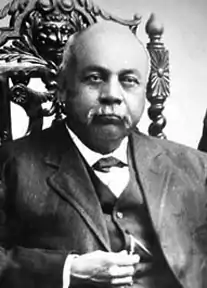

By the early twentieth century, the United States government had passed laws that reduced the Choctaw's sovereignty and tribal rights in preparation for the extinguishing of land claims and for Indian Territory to be admitted, along with Oklahoma Territory, as part of the State of Oklahoma.
Under the Dawes Act, in violation of earlier treaties, the Dawes Commission registered tribal members in official rolls. It forced individual land allotments upon the Tribe's heads of household, and the government classified land beyond these allotments as "surplus", and available to be sold to both native and non-natives. It was primarily intended for European-American (white) settlement and development.
The government created "guardianship" by third parties who controlled allotments while the owners were underage. During the oil boom of the early 20th century, the guardianships became very lucrative; there was widespread abuse and financial exploitation of Choctaw individuals. Charles Haskell, the future governor of Oklahoma, was among the white elite who took advantage of the situation.[46]
An Act of 1906 spelled out the final tribal dissolution agreements for all of the five civilized tribes and dissolved the Choctaw government. The Act also set aside a timber reserve, which might be sold at a later time; it specifically excluded coal and asphalt lands from allotment. After Oklahoma was admitted as a state in 1907, tribal chiefs of the Choctaw and other nations were appointed by the Secretary of the Interior.[47]
Pioneering the use of code talking (1918)
During World War I the American army fighting in France became stymied by the Germans' ability to intercept its communications. The Germans successfully decrypted the codes, and were able to read the Americans' secrets and know their every move in advance.[48]
Several Choctaw serving in the 142nd Infantry suggested using their native tongue, the Choctaw language, to transmit army secrets. The Germans were unable to penetrate their language. This change enabled the Americans to protect their actions and almost immediately contributed to a turn-around on the Meuse-Argonne front. Captured German officers said they were baffled by the Choctaw words, which they were completely unable to translate. According to historian Joseph Greenspan, the Choctaw language did not have words for many military ideas, so the code-talkers had to invent other terms from their language. Examples are "'big gun' for artillery, 'little gun shoot fast' for machine gun, 'stone' for grenade and 'scalps' for casualties."[48] Historians credit these soldiers with helping bring World War I to a faster conclusion.
There were fourteen Choctaw Code Talkers. The Army repeated the use of Native Americans as code talkers during World War II, working with soldiers from a variety of American Indian tribes, including the Navajo. Collectively the Native Americans who performed such functions are known as code talkers.
Citizenship (1920s)
The Burke Act of 1906 provided that tribal members would become full United States citizens within 25 years, if not before. In 1928 tribal leaders organized a convention of Choctaw and Chickasaw tribe members from throughout Oklahoma. They met in Ardmore to discuss the burdens being placed upon the tribes due to passage and implementation of the Indian Citizenship Act and the Burke Act. Since their tribal governments had been abolished, the tribes were concerned about the inability to secure funds that were due them for leasing their coal and asphalt lands, in order to provide for their tribe members. Czarina Conlan was selected as chair of the convention. They appointed a committee composed of Henry J. Bond, Conlan, Peter J. Hudson, T.W. Hunter and Dr. E. N Wright, for the Choctaw; and Ruford Bond, Franklin Bourland, George W. Burris, Walter Colbert and Estelle Ward, for the Chickasaw to determine how to address their concerns.[49]
After meeting to prepare the recommendation, the committee broke with precedent when it sent Czarina Conlan (Choctaw) and Estelle Chisholm Ward (Chickasaw) to Washington, D.C. to argue in favor of passage of a bill proposed by U.S. House Representative Wilburn Cartwright. It proposed sale of the coal and asphalt holdings, but continuing restrictions against sales of Indian lands. This was the first time that women had been sent to Washington as representatives of their tribes.[50]
Termination efforts in the 1950s
From the late 1940s through the 1960s, the federal government considered an Indian termination policy, to end the special relationship of tribes. Retreating from the emphasis of self-government of Indian tribes, Congress passed a series of laws to enable the government to end its trust relationships with native tribes. On 13 August 1946, it passed the Indian Claims Commission Act of 1946, Pub. L. No. 79-726, ch. 959. Its purpose was to settle for all time any outstanding grievances or claims the tribes might have against the U.S. for treaty breaches (which were numerous), unauthorized taking of land, dishonorable or unfair dealings, or inadequate compensation on land purchases or annuity payments. Claims had to be filed within a five-year period.
Most of the 370 complaints submitted were filed at the approach of the 5-year deadline in August 1951.[51]
In 1946, the government had appropriated funds for the sale of Choctaw tribal coal and asphalt resources. Though the Choctaw won their case, they were charged by the courts with almost 10% of the $8.5 million award in administrative fees. In 1951, the tribe took advantage of the new law and filed a claim for over $750,000 to recover those fees.[52]
When Harry J. W. Belvin was appointed chief of the Choctaw in 1948 by the Secretary of the Interior, he realized that only federally recognized tribes were allowed to file a claim with the Commission. If he wanted to get that money back, his tribe needed to reorganize and re-establish its government. He created a democratically elected tribal council and a constitution to re-establish a government, but his efforts were opposed by the Area Director of the Bureau of Indian Affairs.
Ultimately, the Choctaw filed a claim with the Claims Commission on a technicality in 1951. The suit was classified as a renewal of the 1944 case against the US Court of Claims, but that did not stop the antagonism between Belvin and the area BIA officials.[47] The BIA had had management issues for decades. Poorly trained personnel, inefficiency, corruption, and lack of consistent policy plagued the organization almost from its founding.[53] For Belvin, relief from BIA oversight of policies and funds seemed as if it might enable the Choctaw to maintain their own traditional ways of operating and to reform their own governing council.[47]
After eleven years as Choctaw chief, Belvin persuaded Representative Carl Albert of Oklahoma to introduce federal legislation to begin terminating the Choctaw tribe.[47] On 23 April 1959, the BIA confirmed that H.R. 2722 had been submitted to Congress at the request of the tribe. It would provide for the government to sell all remaining tribal assets, but would not affect any individual Choctaw earnings. It also provided for the tribe to retain half of all mineral rights, to be managed by a tribal corporation.[54]
On 25 August 1959, Congress passed a bill[55] to terminate the tribe; it was called "Belvin's law" because he was the main advocate behind it. Belvin created overwhelming support for termination among tribespeople through his promotion of the bill, describing the process and expected outcomes. Tribal members later interviewed said that Belvin never used the word "termination" for what he was describing, and many people were unaware he was proposing termination.[56] The provisions of the bill were intended to be a final disposition of all trust obligations and a final "dissolution of the tribal governments."[54]
The original act was to have expired in 1962, but was amended twice to allow more time to sell the tribal assets. As time wore on, Belvin realized that the bill severed the tribe members' access to government loans and other services, including the tribal tax exemption. By 1967, he had asked Oklahoma Congressman Ed Edmondson to try to repeal the termination act.[47] Public sentiment was changing as well. The Choctaw people had seen what termination could do to tribes, since they witnessed the process with four other tribes in Oklahoma: the Wyandotte Nation, Peoria Tribe of Indians of Oklahoma, Ottawa Tribe of Oklahoma, and Modoc Tribe of Oklahoma. In 1969, ten years after passage of the Choctaw termination bill and one year before the Choctaws were to be terminated, word spread throughout the tribe that Belvin's law was a termination bill. Outrage over the bill generated a feeling of betrayal, and tribal activists formed resistance groups opposing termination. Groups such as the Choctaw Youth Movement in the late 1960s fought politically against the termination law. They helped create a new sense of tribal pride, especially among younger generations. Their protest delayed termination; Congress repealed the law on 24 August 1970.[56]
Self-determination 1970s-present
The 1970s were a crucial and defining decade for the Choctaw. To a large degree, the Choctaw repudiated the more extreme Indian activism. They sought a local grassroots solution to reclaim their cultural identity and sovereignty as a nation.
Republican President Richard Nixon, long sympathetic to American Indian rights, ended the government's push for termination. On August 24, 1970, he signed a bill repealing the Termination Act of 1959, before the Choctaw would have been terminated. Some Oklahoma Choctaw organized a grassroots movement to change the direction of the tribal government. In 1971, the Choctaw held their first popular election of a chief since Oklahoma entered the Union in 1907. Nixon stated the tribes had a right to determine their own destiny.
A group calling themselves the Oklahoma City Council of Choctaws endorsed thirty-one-year-old David Gardner for chief, in opposition to the current chief, seventy-year-old Harry Belvin. Gardner campaigned on a platform of greater financial accountability, increased educational benefits, the creation of a tribal newspaper, and increased economic opportunities for the Choctaw people. Amid charges of fraud and rule changes concerning age, Gardner was declared ineligible to run. He did not meet the new minimum age requirement of thirty-five. Belvin was re-elected to a four-year term as chief.
In 1975, thirty-five-year-old David Gardner defeated Belvin to become the Choctaw Nation's second popularly elected chief. 1975 also marked the year that the United States Congress passed the landmark Indian Self-Determination and Education Assistance Act, which had been supported by Nixon before he resigned his office due to the Watergate scandal. This law revolutionized the relationship between Indian Nations and the federal government by providing for nations to make contracts with the BIA, in order to gain control over general administration of funds destined for them.
Native American tribes such as the Choctaw were granted the power to negotiate and contract directly for services, as well as to determine what services were in the best interest of their people. During Gardner's term as chief, a tribal newspaper, Hello Choctaw, was established. In addition, the Choctaw directed their activism at regaining rights to land and other resources. With the Creek and Cherokee nations, the Choctaw successfully sued the federal and state government over riverbed rights to the Arkansas River.
Discussions began on the issue of drafting and adopting a new constitution for the Choctaw people. A movement began to increase official enrollment of members, increase voter participation, and preserve the Choctaw language. In early 1978, David Gardner died of cancer at the age of thirty-seven. Hollis Roberts was elected chief in a special election, serving from 1978 to 1997.
In June 1978 the Bishinik replaced Hello Choctaw as the tribal newspaper. Spirited debates over a proposed constitution divided the people. In May 1979, they adopted a new constitution for the Choctaw nation.
Faced with termination as a sovereign nation in 1970, the Choctaws emerged a decade later as a tribal government with a constitution, a popularly elected chief, a newspaper, and the prospects of an emerging economy and infrastructure that would serve as the basis for further empowerment and growth.
Notable tribal members
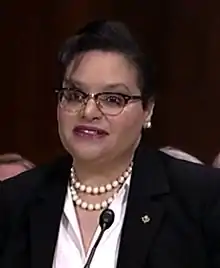


- Wallace Willis, composer of Negro spirituals, including Swing Low, Sweet Chariot and Roll, Jordan, Roll, Choctaw slave and Freedmen owned by Britt Willis
- Lane Adams (b. 1989), Major League Baseball player, Philadelphia Phillies (nephew of Choctaw member and attorney Kalyn Free)
- Marcus Amerman (b. 1959), bead, glass, and performance artist
- David W. Anderson, 9th Assistant Secretary of the Interior for Indian Affairs
- Jim Weaver Barnes (b. 1933), poet, writer, rancher and former professor
- Gary Batton, (b. 1966), Chief of the Choctaw Nation
- Judge Ada E. Brown, (b. 1974), federal judge of the United States District Court for the Northern District of Texas
- Michael Burrage (b. 1950), former U.S. District Judge
- Sean Burrage (b. 1968), President of Southeastern Oklahoma State University
- Steve Burrage (b. 1952), former Oklahoma State Auditor and Inspector
- Choctaw Code Talkers, World War I veterans who provided a secure means of communication in their language; first Native American code talkers
- Clarence Carnes (1927–1988), imprisoned at Alcatraz
- Tonya Crews (1938-1966), Playboy Playmate model Centerfold for March 1961
- Czarina Conlan (1871-1958), suffragist, first woman to represent the Choctaw in Washington, D.C. and first woman elected to a school board in Oklahoma
- Samantha Crain (b. 1986), singer-songwriter, musician
- Tobias William Frazier, Sr. (1892–1975), Choctaw code talker
- Te Ata Fisher, (1895-1995), (Mary Francis Thompson Fisher), 1/4 Choctaw, Chickasaw.
- Scott Fetgatter (b. 1968), Member of the Oklahoma House of Representatives from the 16th district
- Kalyn Free, attorney
- Rosella Hightower (1920–2008), prima ballerina
- Norma Howard, visual artist
- LeAnne Howe, writer and academic
- Phil Lucas (1942–2007), filmmaker
- Linda Lomahaftewa (b. 1947), printmaker, painter, and educator
- Green McCurtain (d. 1910), Chief from 1902–1910 (appointed by US government 1906-1910)
- Cal McLish (1925–2010), Major League Baseball pitcher
- Devon A. Mihesuah (b. 1957), author, editor, historian
- Joseph Oklahombi (1895-1960), Choctaw code talker
- Peter Pitchlynn (1806–1881), Chief from 1860–1866
- Gregory E. Pyle (1949-2019), former Chief of the Choctaw Nation
- Hollis E. Roberts (1943-2011), former Chief of the Choctaw Nation
- Oral Roberts (1918-2009), evangelist
- R. Trent Shores, United States Attorney for the Northern District of Oklahoma since 2017
- William Grady Stigler (1891-1952), U.S. Representative from Oklahoma 2nd District, 1944–52
- Bryan Terry (b. 1968), Member of the Tennessee House of Representatives from the 48th district
- Tim Tingle, writer and storyteller
- Wilma Victor (1919–1987), educator, first lieutenant in Women's Army Corps (1943-1946), special assistant to Secretary of the Interior Rogers Morton (1971-1975)
- Summer Wesley, attorney, writer, and activist
- James Winchester (b. 1989), National Football League player
- Allen Wright (1826-1885), Chief from 1866–1870
- Muriel Hazel Wright (1889-1975), teacher, historian and writer, granddaughter of Chief Allen Wright
See also
- John Hope Franklin, African-American historian whose mother was of partial Choctaw descent
- Anna Lewis, teacher, historian and writer of partial Choctaw descent
- Ward Connerly, political activist, businessman, and former University of California Regent of partial Choctaw descent
- Choctaw culture
- Choctaw mythology
- Choctaw Trail of Tears
- Jena Band of Choctaw Indians, Louisiana
- Mississippi Band of Choctaw Indians
- List of Indian Reservations
Notes
- Mayhew mission was abandoned when the Choctaws left, and remained vacant. The remaining townspeople moved when the Mobile and Ohio Railroad bypassed the community in 1857. Almost nothing except the cemetery and the church remains of the original community.[37]
References
- "2011 Oklahoma Indian Nations Pocket Pictorial Directory" (PDF). Oklahoma Indian Affairs Commission. September 2011. Archived from the original (PDF) on October 27, 2011. Retrieved December 31, 2011.
- "History". www.choctawnation.com/. Retrieved 2020-09-03.
- "Annual Report of the Secretary of the Interior for the Fiscal Year". 1916.
- (PDF) https://web.archive.org/web/20120512040555/http://www.ok.gov/oiac/documents/2011.FINAL.WEB.pdf. Archived from the original (PDF) on 2012-05-12. Retrieved 2020-07-11. Missing or empty
|title=(help) - http://www.odot.org/OK-GOV-DOCS/PROGRAMS-AND-PROJECTS/GRANTS/FASTLANE-US69/Reports-Tech-Info/Tribal%20Data.pdf
- "Executive Branch - Choctaw Nation". ChoctawNation.com. Retrieved April 27, 2017.
- Ferguson, Bob; Leigh Marshall (1997). "Chronology". Mississippi Band of Choctaw Indians. Archived from the original on 2007-10-10. Retrieved February 5, 2008.
- Debo, Angie (1934). The Rise and Fall of the Choctaw Republic. University of Oklahoma Press.
- https://www.bbc.co.uk/news/world-us-canada-53358330
- https://www.supremecourt.gov/opinions/19pdf/18-9526_9okb.pdf
- https://www.heralddemocrat.com/news/20200902/choctaw-nation-chief-announces-formation-of-sovereignty-committee
- "Choctaw Nation Opens New Headquarters".
- https://www.choctawnation.com/sites/default/files/import/CB-139-17.pdf
- https://city-sentinel.com/2020/08/analysis-seeking-redress-for-past-wrongdoing-sometimes-where-you-stand-depends-on-where-you-sit/
- "Archived copy" (PDF). Archived from the original (PDF) on 2016-12-25. Retrieved 2017-05-01.CS1 maint: archived copy as title (link)
- "CONTENTdm".
- "Tribal Council Members - Choctaw Nation". choctawnation.com. Archived from the original on 2012-01-03.
- "Constitution of Choctaw Nation 1983". Choctaw Nation of Oklahoma. Archived from the original on 2013-12-14.
- "Choctaw Nation Constitutional Court". Choctawnationcourt.com. Retrieved 2020-07-11.
- "Choctaw Nation Oklahoma Court of Appeals". Choctawnationcourt.com. Retrieved 2020-07-11.
- "Choctaw Nation OK District Court". Choctawnationcourt.com. Retrieved 2020-07-11.
- "Archived copy". Archived from the original on 2010-04-06. Retrieved September 9, 2010.CS1 maint: archived copy as title (link)
- "Great Companies Spotlight: Sovereign Nations | Oklahoma Magazine".
- "Choctawnationhealth.com". Archived from the original on September 6, 2015. Retrieved April 27, 2017.
- Sharyn Kane & Richard Keeton. "As Long as Grass Grows". Fort Benning - The Land and the People. SEAC. Retrieved August 7, 2010.
- Remini, Robert. "Brothers, Listen ... You Must Submit". Andrew Jackson. History Book Club. p. 272. ISBN 0-9650631-0-7.
- Green, Len (October 1978). "Choctaw Treaties". Bishinik. Archived from the original on 2007-12-15. Retrieved March 21, 2008.
- Len Green (2009). "President Andrew Jackson's Original Instructions to the "Civilized" Indian Tribes to Move West". The Raab Collection. Archived from the original on 2011-07-15. Retrieved 2009-09-28.
- Remini, Robert. "Brothers, Listen ... You Must Submit". Andrew Jackson. History Book Club. ISBN 0-9650631-0-7.
- Kappler, Charles (1904). "INDIAN AFFAIRS: LAWS AND TREATIES Vol. II, Treaties". Government Printing Office. Archived from the original on 2008-05-17. Retrieved 2008-04-16.
- Baird, David (1973). "The Choctaws Meet the Americans, 1783 to 1843". The Choctaw People. United States: Indian Tribal Series. p. 36. LCCN 73-80708.
- Council of Indian Nations (2005). "History & Culture, Citizenship Act - 1924". Council of Indian Nations. Retrieved 2008-05-02.
- Carleton, Ken (2002). "A Brief History of the Mississippi Band of Choctaw Indians" (PDF). Mississippi Archaeological Association. Retrieved 2009-05-04.
- Kidwell (2007); Kidwell (1995)
- "An Indian Candidate for Congress". Christian Mirror and N.H. Observer, Shirley, Hyde & Co. July 15, 1830.
- H.R. Rep. No. 496, pt. 1, at 7 (Jan. 23, 1906)
- Herrick, C. L. "Mayhew, Lowndes County, Mississippi." Lowndes, Mississippi Genealogy & History Network. 2017. Accessed March 24, 2018.
- Morris, John (1977). Ghost Towns of Oklahoma. Norman, Oklahoma: University of Oklahoma Press. p. 229. ISBN 978-0-8061-1420-0.
- Ward, Mike (1992). "Irish Repay Choctaw Famine Gift: March Traces Trail of Tears in Trek for Somalian Relief". American-Stateman Capitol. Archived from the original on 2007-10-25. Retrieved 2007-09-20.
- Spring, Joel (1996). Books on Google Play The Cultural Transformation of A Native American Family and Its Tribe 1763–1995: A Basket of Apples. New York, London: Routledge (Taylor & Francis Group). ISBN 0-8058-2303-4.
in 1855, the American Board decided to send George Wood to investigate the situation in Indian Missions... While visiting the Choctaw Nation, Wood spent 3 days each at the Wheelock and Spencer Academies, and 9 days at other schools
- Cassity, Michael; Goble, Danney (2009). Divided Hearts: The Presbyterian Journey Through Oklahoma History. Norman: University of Oklahoma Press. pp. 77–80. ISBN 978-0-8061-3848-0. Retrieved August 24, 2016.
members of the mission met Wood at Goodwater Mission, a school that had been suspended since 1853 ... Part of the key [to cordial discussion] was Wood's decision at the outset to 'drop for the present' the contentious letter from the American Board of June 22, 1848
- Nichols, Max (2009-09-27). "Fort Towson vicinity boasts rich history". Daily Oklahoman. Retrieved 2009-10-04.
- "Doaksville." Oklahoma Historical Society. Retrieved August 7, 2014.
- Debo, Angie (1934). "Life in the New Land". The Rise and Fall of the Choctaw Republic. University of Oklahoma Press. p. 78.
- The War of the Rebellion, Series IV, Volume II. 1900. p. 353.
- Angie Debo, And Still the Waters Run, Princeton University Press, 1972, pg 159-180
- Kidwell, Clara Sue (2002). "The Resurgence of the Choctaws in the Twentieth Century" (PDF). Indigenous Nations Studies Journal. . 3, No. 1 (Spring 2002): 8–10. Retrieved 26 December 2014.
- "World War I’s Native American Code Talkers Greenspan, Joseph. "World War I’s Native American Code Talkers.", History, 29 May 2014. Retrieved August 19, 2014.
- "Chickasaws and Choctaws to Send Delegation to Capital". The Daily Ardmoreite. Ardmore, Oklahoma. March 25, 1928. p. 3. Retrieved 8 August 2016 – via Newspaperarchive.com.

- "Indians Break Precedents to Send Women Representatives". The Daily Ardmoreite. Ardmore, Oklahoma. April 3, 1928. p. 2. Retrieved 8 August 2016 – via Newspaperarchive.com.

- Philp, Kenneth R. (1999). Termination revisited : American Indians on the trail to self-determination, 1933-1953. Lincoln [u.a.]: Univ. of Nebraska Press. pp. 21–33. ISBN 978-0-8032-3723-0. Retrieved 29 December 2014.
- Kidwell 2002, pp. 10–12
- "Indian Lands, Indian Subsidies". Downsizing the Federal Government. February 2012.
- "Department Supports Choctaw Termination Bill Introduced in Congress at the Request of Tribal Representatives" (PDF). Department of the Interior. Archived from the original (PDF) on 10 June 2014. Retrieved 29 December 2014.
- "Public Law 86-192". US Code. Archived from the original on 23 January 2012. Retrieved 29 December 2014.
- Lambert, Valerie (2007). "Political Protest, Conflict, and Tribal Nationalism: The Oklahoma Choctaws and the Termination Crisis of 1959–1970". American Indian Quarterly. University of Nebraska Press. 31, No. 2 (Spring 2007): 283–309. doi:10.1353/aiq.2007.0024. JSTOR 4138948. S2CID 154309883.
External links
- Choctaw Nation of Oklahoma, official website
- Choctaw Nation Health Services Authority
- D. L. Birchfield, "Choctaws." Accessed May 15, 2015.









